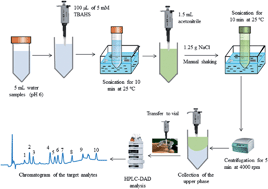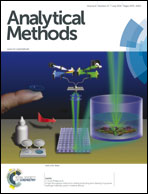Ion-pair assisted liquid–liquid extraction for selective separation and analysis of multiclass pesticide residues in environmental waters
Abstract
A new ion-pair assisted liquid–liquid extraction (IPA-LLE) method in combination with high performance liquid chromatography-diode array detection (HPLC-DAD) has been proposed for the determination of ten multiclass (six sulfonylurea and four organophosphorus ) pesticides in environmental waters. In the IPA-LLE procedure, the ion-pairing reagent tetrabutylammonium hydrogen sulfate and the organic solvent, acetonitrile, were used for extraction of the target analytes. Various parameters influencing the extraction efficiency such as the type, composition and volume of the ion-pair, volume of acetonitrile, sample pH, type and composition of the salt and effect of sonication time were studied and optimal conditions were established. Under the optimum conditions, the limits of detection and quantification of the proposed method were in the ranges of 0.5–3.0 μg L−1 and 1.8–10.0 μg L−1, respectively, and calibration curves were linear within the range of 1.8–450 μg L−1, with coefficients of determination of 0.993 or better. Intra- and inter-day precision studies, expressed as relative standard deviations, at three concentration levels, were in the range of 0.4–9.4%. The relative recoveries of the spiked environmental water samples were in the range of 73–105%, except for nicosulfuron in lake water. The results of the study revealed that the developed method involves efficient sample preparation allowing the preconcentration of analytes, followed by the use of HPLC-DAD for quantitative analysis.


 Please wait while we load your content...
Please wait while we load your content...